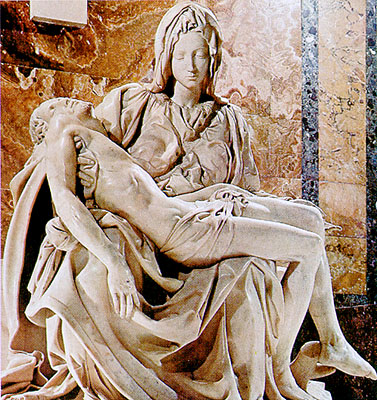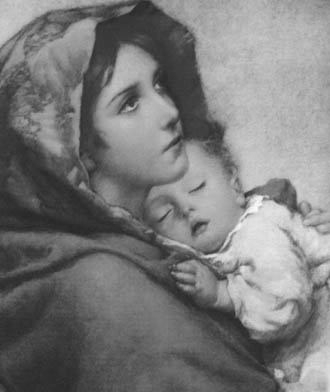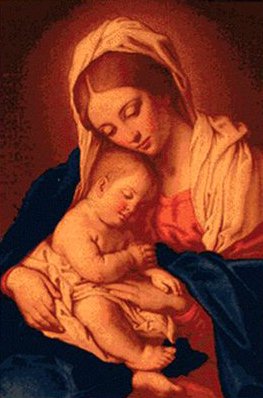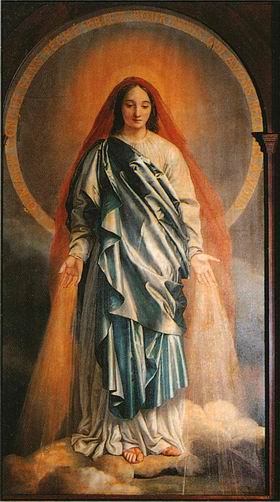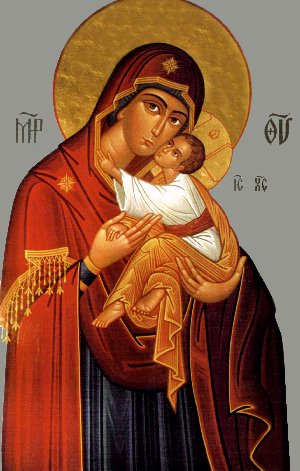 |
||||
|
MARY WITH BRASS KNUCKLESBy Joanna Manning
A few years ago, I was running a high school retreat program out of an ecumenical church outreach centre in Toronto's downtown core. The day was divided into two parts. In the morning, small groups of students walked with a guide to different downtown locations where they could meet and interact with groups of marginalized people. In the afternoon, the students prepared skits as part of a reflection on how their experience related to the Gospel. One of the places they would visit was Sojourn House, an intake centre for refugees. On this particular day, the group that had visited Sojourn House chose to present a dramatic interpretation of the Holy Family's flight into Egypt. This took the form of an encounter between Mary and Joseph, refugee claimants arriving at the Egyptian border, being questioned by Egyptian immigration control. The student who played Mary was a vibrant, self-confident young woman. Dressed in punk style, she sported a ring in her nose and a crown of short pink hair. The skit opened with Mary and Joseph, the infant Jesus in their arms, arriving at the Egyptian border to claim refugee status. The students playing the immigration officers framed their questions to show the contemporary prejudices often displayed towards refugees and immigrants. "Why are you here?" they demanded. "Why should our people's taxes be used to support your kid? Aren't you just here to take advantage of our welfare system and free health care?" and "How many so-called relatives of yours are going to come through here after you?"
At a couple of stages during the altercation, Mary pounded the table with her fist and shouted at the border guards. She, her child, and her man Joseph, she insisted, were fleeing from death squads and desperately needed shelter. If they were turned back, they faced certain death. In the debriefing afterwards, I commented that I thought her portrayal of Mary might have been a tad too aggressive. She looked me straight in the eye and responded, "But this Mary has brass knuckles!" I wished that I had been an artist and could have painted an icon of this new image of Mary, revealed to me though the eyes of this contemporary woman. A Mary with brass knuckles, as liberation theologians have pointed out, is actually closer to the New Testament Mary than the more recent transmogrification of her into the sweetly cloying model of subservient womanhood. Mary's longest statement, the Magnificat that is placed on her lips by Luke the evangelist, is one of the most powerful statements in the Bible. God, says this woman with brass knuckles, will cast down mighty ones from their thrones, scatter the proud in their conceits, and send the rich away empty- handed.
Asian theologian Tissa Balassuriya, whose writings have caused some of the powerful seated on their cathedral thrones today to tremble, says that this Magnificat proposes a threefold revolution. First, a cultural revolution, in which the proud and haughty upper classes of church and society are rejected in favor of the marginalized. Then a political revolution, in which power passes into the hands of the poor: and finally, an economic revolution, in which the world's resources will be redistributed to the poor, with the rich getting the raw end of the deal. Papal documents, however, continue to present Mary as a model of the non- threatening kind of womanhood acceptable to the clergy. The Pope's Mary, in the words of writer Mary Gordon, "is a stick to beat smart girls with." Uppity women who demand equal access to all the sacraments of the church, including ordination, have been told that this is false to their Marian/maternal nature, which does not include the gift of governance of Mother church. The asexual maternal, but virginal figure of the Madonna, has also provided a safe repository for the projection of repressed celibate sexual desire. A woman who has a baby but who does not have sex in the process is safely beyond lust. Women who do not fit this role -and what woman in fact ever has?- are often portrayed as a shadow side of Mary, personified in the person of Eve the temptress, responsible for sexual temptation and the fall of man from grace.
Conservative Catholic spirituality also emphasizes a privatized devotion to Mary. Women who wish to emulate the virtues of Mary's submission must return to their traditional role in the home. Their unpaid domestic service to husband and family is a sign of the selfless love that will keep their man and children on the straight and narrow. This indirectly supports the proliferation of the global reach of consumer market forces. Shopping is viewed as a harmless diversion from this routine. Devoid of systemic social critique of market forces, women who are trapped in the consumerism of the "buy and be happy" ideology of the one-third rich world are eager recipients of whatever new fashion the corporate market has invented for them. The price of the fleeting pleasure of shopping is paid in the sweatshops that enslave their sisters in the south. Mary, the conservative argument also goes, stood in noble silence at the foot of the cross and internalized her suffering. Women have been led to believe that the silent acceptance of domestic suffering offered up for the redemption of their men is a way for them to save themselves and their partners. This kind of thinking continues to place many women in Catholic cultures at risk of abuse.
Feminist and liberation theologians reject a suffering or totally silent Mary in favor of more powerful and assertive images. Mary is increasingly hailed as the prophetic advocate of justice, a poor woman of the people whose influence over Jesus was instrumental in shaping his ministry. The Magnificat of Mary and the Beatitudes of Jesus taken together outline a new human order: a "kindom" of equals rather than the hierarchically-structured kingdom of the church, and organized around God's preferential option for the poor. This Mary traveled with the disciples and helped shape the early church after Pentecost. At the time of the flight into Egypt, Mary was a teenage mother. She lived in occupied territory and had to flee to save her life and that of her son. No wonder this Mary had brass knuckles.
Joanna Manning is the author of "Is The Pope Catholic?: A Women Confronts Her Church" published by Crossroad Publishing. She has been a teacher in high school and university for 30 years. In 1995, Manning received the Ontario English Catholic Teachers Association's Marion Tyrell Award for outstanding contribution to Catholic Education. She also runs a weekly breakfast for homeless and poor people in Toronto.
|
|
|||
|
|
||||
|
|
||||
 |
|
 |
||
